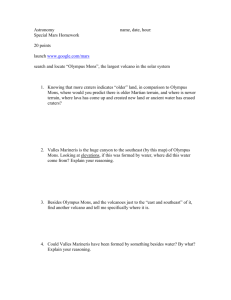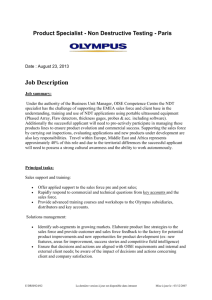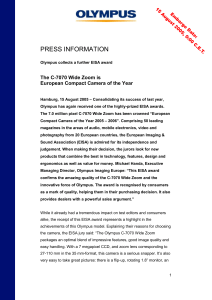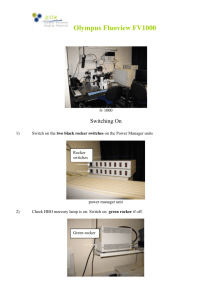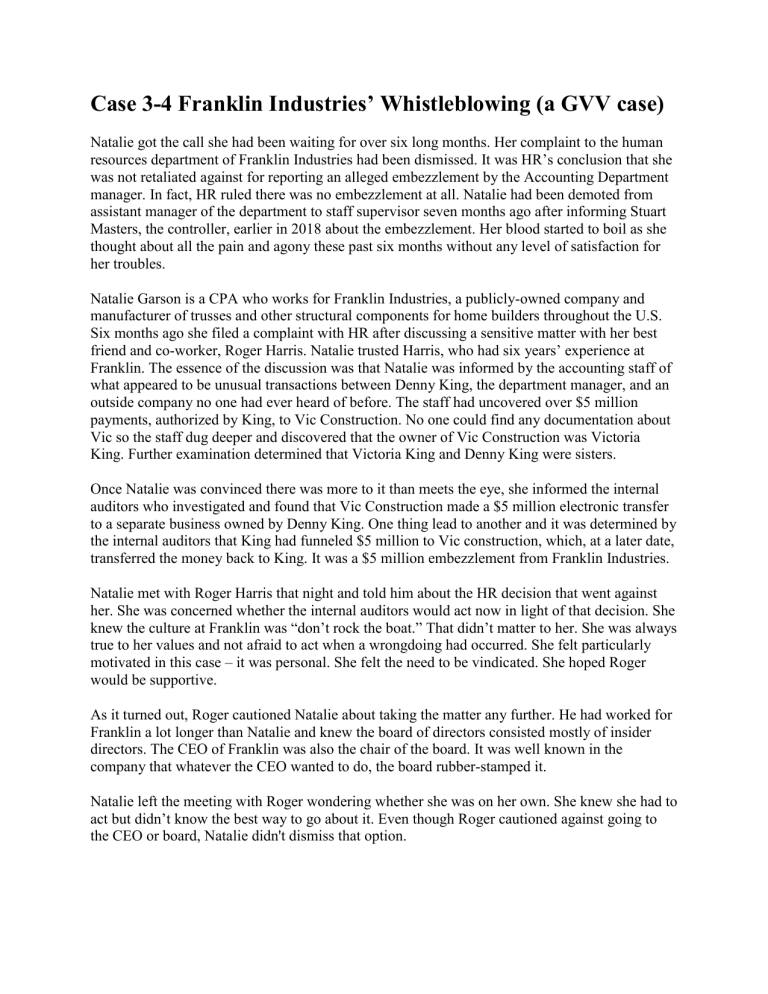
Case 3-4 Franklin Industries’ Whistleblowing (a GVV case) Natalie got the call she had been waiting for over six long months. Her complaint to the human resources department of Franklin Industries had been dismissed. It was HR’s conclusion that she was not retaliated against for reporting an alleged embezzlement by the Accounting Department manager. In fact, HR ruled there was no embezzlement at all. Natalie had been demoted from assistant manager of the department to staff supervisor seven months ago after informing Stuart Masters, the controller, earlier in 2018 about the embezzlement. Her blood started to boil as she thought about all the pain and agony these past six months without any level of satisfaction for her troubles. Natalie Garson is a CPA who works for Franklin Industries, a publicly-owned company and manufacturer of trusses and other structural components for home builders throughout the U.S. Six months ago she filed a complaint with HR after discussing a sensitive matter with her best friend and co-worker, Roger Harris. Natalie trusted Harris, who had six years’ experience at Franklin. The essence of the discussion was that Natalie was informed by the accounting staff of what appeared to be unusual transactions between Denny King, the department manager, and an outside company no one had ever heard of before. The staff had uncovered over $5 million payments, authorized by King, to Vic Construction. No one could find any documentation about Vic so the staff dug deeper and discovered that the owner of Vic Construction was Victoria King. Further examination determined that Victoria King and Denny King were sisters. Once Natalie was convinced there was more to it than meets the eye, she informed the internal auditors who investigated and found that Vic Construction made a $5 million electronic transfer to a separate business owned by Denny King. One thing lead to another and it was determined by the internal auditors that King had funneled $5 million to Vic construction, which, at a later date, transferred the money back to King. It was a $5 million embezzlement from Franklin Industries. Natalie met with Roger Harris that night and told him about the HR decision that went against her. She was concerned whether the internal auditors would act now in light of that decision. She knew the culture at Franklin was “don’t rock the boat.” That didn’t matter to her. She was always true to her values and not afraid to act when a wrongdoing had occurred. She felt particularly motivated in this case – it was personal. She felt the need to be vindicated. She hoped Roger would be supportive. As it turned out, Roger cautioned Natalie about taking the matter any further. He had worked for Franklin a lot longer than Natalie and knew the board of directors consisted mostly of insider directors. The CEO of Franklin was also the chair of the board. It was well known in the company that whatever the CEO wanted to do, the board rubber-stamped it. Natalie left the meeting with Roger wondering whether she was on her own. She knew she had to act but didn’t know the best way to go about it. Even though Roger cautioned against going to the CEO or board, Natalie didn't dismiss that option. Questions Assume you are in Natalie’s position. Answer the following questions. 1. What are the ethical values in this case? What about professional values? The values are coming from insiders of the company, Denny king in this case. Denny King is unethically and illegally sending money to an affiliated company and redirecting the money back to him. Natalie is showing ethical values of integrity and responsibility to making sure this act gets acknowledged, and does not get overlooked. Professional Values on the behalf of the company are dismissing and are greedy. Consider the following assuming you have decided to do something about the embezzlement: o What are the main arguments you are trying to counter. That is, what are the reasons and rationalizations you need to address? There has been $5 million worth of payment to an outside company, which seems to had multiple inside transactions to transfer the money to a personal back of the initial sender. Denny King sent these payments to Vic Construction which seems to have personal relations, Victoria King, which is the owner of Vic Construction, as well sister of Denny King. Determined by internal Auditors, there were transactions showing $5 million worth of transferred money from Vic Construction to one of Denny’s separate business. o What is at stake for the key parties, including those who disagree with you? Well getting Audited by the IRS. If the IRS catches on these suspicious transactions between the two, an IRS agent can call for an Audit which can easily detect unethical/illegal practices. Therefore resulting in Fines, Arrest, and can threaten the companies reputation. o What levers can you use to influence those who disagree with you? I would lever what is at stake for them. As the department manager being the one authorizing these transactions, they can easily trace back to Denny. If they are looking for a quick burst of money, they are forgetting about the long term and should consider what punishment can be enforced. o What is your most powerful and persuasive response to the reasons and rationalizations you need to address? To whom should the argument be made? When and in what context? Since Natalie has already gone to HR and they have responded back negatively to her, I may go to an outside source. Whether it is writing a report and sending it to an Auditing or News company, or filing an official complaint to the IRS in hopes of the case being resolved, both can be considered potential support. 2. Assume you have exhausted all your options within Franklin Industries. Is this a situation where you would consider filing a complaint with the SEC under the Sarbanes-Oxley Act? What about Dodd-Frank? Explain. Yes, I could complain under SOX, because in this case, the internal Auditors are giving false reports that are not unaltered. There should also be a separation of power, where Denny King should not be able to send off large sums of money without approval from a secondary manager, or someone to verify this money is not being fraudulently sent off to a “client”. Case 3-7 Olympus Summary of the Case On September 25, 2012, Japanese camera and medical equipment maker Olympus Corporation and three of its former executives pleaded guilty to charges related to an accounting scheme and cover-up in one of Japan’s biggest corporate scandals. Olympus admitted that it tried to conceal investment losses by using improper accounting under a scheme that began in the 1990s. The scandal was exposed in 2011 by Olympus’s then-CEO, Michael C. Woodford. As the new President of Olympus, he felt obliged to investigate the matter and uncovered accounting irregularities and suspicious deals involving the acquisition of UK medical equipment manufacturer Gyrus. He called the company’s auditors, PwC, to report it. The firm examined payments of $687 million related to financial advice on the acquisition paid to a non-existent Cayman Islands firm. A fraud of $1.7 billion emerged, including an accounting scandal to hide the losses. Along the way, the Japanese way of doing business came under attack by Woodford. Olympus initially said that it fired Woodford, one of a handful of foreign executives at top Japanese companies, over what it called his aggressive Western management style. Woodford disclosed internal documents to show he was dismissed after he raised questions about irregular payouts related to mergers and acquisitions. Without any serious attempt by management to investigate, he went behind the board’s back and commissioned a report by PwC into the Gyrus deal, including the unusually high advisory fee and apparent lack of due diligence. On October 11, 2011, he circulated the report to the board and called on chair of the board, Tsuyoshi Kikukawa, and executive vice president, Hisashi Mori, to resign. Three days later, the board fired Woodford. Ultimately, the accounting fraud was investigated by the Japanese authorities. “The full responsibility lies with me and I feel deeply sorry for causing trouble to our business partners, shareholders and the wider public,” Kikukawa, told the Tokyo district court. “I take full responsibility for what happened.” Prosecutors charged Kikukawa, Mori, and a former internal auditor, Hideo Yamada, with inflating the company’s net worth in financial statements for five fiscal years to March 2011 due to accounting for risky investments made in the late-1980s bubble economy. The three former executives had been identified by an investigative panel, commissioned by Olympus, as the main suspects in the fraud. In December 2011, Olympus filed five years’ worth of corrected financial statements plus overdue first-half results, revealing a $1.1 billion hole in its balance sheet. On April 28, 2017, following six years of scandal-ridden disclosures, a Tokyo court found Kikukawa and five others liable for $529 million. Kikukawa and two other executives who pleaded guilty never went to jail. Instead, they were given suspended sentences of up to three years. Olympus Spent Huge Sums on Inflated Acquisitions, Advisory Fees to Conceal Investment Losses Olympus’s cover-up of massive losses has shed light on several murky methods that some companies employed to clean up the mess left after Japan’s economic bubble burst. Many companies turned to speculative investments as they suffered sluggish sales and stagnant operating profits. The company used “loss-deferring practices” to make losses look smaller on the books by selling bad assets to related companies. To take investment losses off its books, Olympus spent large sums of money to purchase British medical equipment maker Gyrus Group PLC and three Japanese companies and paid huge consulting fees. Olympus is suspected of having deliberately acquired Gyrus at an inflated price, and in the year following the purchases, it booked impairment losses as a result of decreases in the companies’ value. To avert a rapid deterioration of its financial standing, Olympus continued corporate acquisitions and other measures for many years, booking impairment losses to improve its balance sheet. Losses on the purchases of the three Japanese companies amounted to $34.5 billion. With money paid on the Gyrus deal included, Olympus may have used more than $62.5 billion in funds for past acquisitions to conceal losses on securities investments. The previous method that recorded stocks and other financial products by book value—the price when they were purchased—was abolished. The new method listed them by market value (markto-market accounting). Under this change, Olympus had to report all the losses in its March 2001 report. However, Olympus anticipated this change a year in advance and posted only about $10.6 billion of the nearly $62.5 billion yen as an extraordinary loss for the March 2000 settlement term. The company did not post the remainder as a deficit; rather, it deferred it using questionable measures. Olympus’s Tobashi Scheme At the heart of Olympus’s action, was a once-common technique to hide losses called tobashi, which Japanese financial regulators tolerated before clamping down on the practice in the late 1990s. Tobashi, translated loosely as “to blow away,” enables companies to hide losses on bad assets by selling those assets to other companies, only to buy them back later through payments, often disguised as advisory fees or other transactions, when market conditions or earnings improve. Tobashi allows a company with the bad assets to mask losses temporarily, a practice banned in the early 2000s. The idea is that you pay off the losses later, when company finances are better. Olympus appears to have pushed to settle its tobashi amounts from 2006 to 2008, when the local economy was picking up and corporate profits rebounding, in an effort to “clean up its act.” Business was finally strong enough to be able to withstand a write-down. It was during those years that the company engineered the payouts that came under scrutiny: $687 million in fees to an obscure financial adviser over Olympus’s acquisition of Gyrus in 2008, a fee that was roughly a third of the $2 billion acquisition price, more than 30 times the norm. Olympus also acquired three small Japanese companies from 2006 to 2008 with little in common with its core business for a total of $773 million, only to write down most of their value within the same fiscal year. Olympus Scandal Raises Questions about the “Japan Way” of Doing Business The scandal rocked corporate Japan, not least because of the company’s succession of firings, denials, admissions, and whistleblowing. It also exposed weaknesses in Japan’s financial regulatory system and corporate governance. “This is a case where Japan’s outmoded practice of corporate governance remained and reared its ugly head,” according to Shuhei Abe, president of Tokyo-based Sparx Group Company. “With Olympus’s case, it will no longer be justifiable for Japan Inc. to continue practicing under the excuse of the ‘Japan way of doing things.” On the surface, Olympus seemed to have checks on its management. For example, it hired directors and auditors from outside the company, as well as a British president who was not tied to corporate insiders. In reality, however, the company’s management was ruled by former chairman Kikukawa and a few other executives who came from its financial sections. The company’s management is believed to have been effectively controlled by several executives who had a background in financial affairs, including Kikukawa and Mori, both of whom were involved in the cover-up of past losses. Olympus’s board of auditors, which is supposed to supervise the board of directors, includes full-time auditor Hideo Yamada, who also had financial expertise. After Woodford made his allegations, he was confronted by a hostile board of directors that acted based on the premise that whistleblowing offended their corporate culture. Subsequently, the board fired him saying that he had left because of “differences in management styles.” Employees were warned not to speak to them or jeopardize their careers. One problem with corporate governance in Japan is truly independent non-executive directors are unusual. Many Japanese do not see the need for such outside intervention. They question how outsiders can know enough about the company to make a valuable contribution. Moreover, how could they be sensitive to the corporate culture? They could even damage the credibility of the group. Accounting Explanations Olympus hid a $1.7 billion loss through an intricate array of transactions. A one paragraph summary of what it did appears in the investigation report: The lost disposition scheme is featured in that Olympus sold the assets that incurred loss to the funds set up by Olympus itself, and later provided the finance needed to settle the loss under the cover of the company acquisitions. More specifically, Olympus circulated money either by flowing money into the funds by acquiring the entrepreneurial ventures owned by the funds at the substantially higher price than the real values, or by paying a substantially high fees to the third party who acted as the intermediate in the acquisition, resulting in recognition of large amount of goodwill, and subsequently amortized goodwill recognized impairment loss, which created substantial loss. Here is a more understandable version of the event: Olympus indirectly loaned money to an off-the-books subsidiary and then sold the investments that had the huge losses to the subsidiary at historical cost, eventually paying a huge premium to buy some other small companies and writing off the underwater investments as if they were goodwill impairments. A more detailed bookkeeping analysis of the complicated transactions appears in Exhibit 1. Auditor Responsibilities Arthur Andersen was the external auditor through March 31, 2002, after which Andersen closed its doors for good in the post-Enron era. Then KPMG AZSA LLC was the auditor through March 31, 2009. The 2010 and 2011 fiscal years were audited by Ernst & Young ShinNihon LLC. The investigative report noted that the fraud was hidden quite well. Three banks were involved in hiding information from the auditors. The summary report said that all three of them agreed not to tell auditors the information that would normally be provided on an audit confirmation. KPMG did come across one of the tobashi schemes carried out through one of the three different routes that had been set up. According to the investigative report: Not everything was going smoothly. The report said that in 1999, Olympus’s then-auditor, KPMG AZSA LLC, came across information that indicated the company was engaged in tobashi, which recently had become illegal in Japan. Mori and Yamada initially denied KPMG’s assertion, but the auditor pushed them that same year to admit to the presence of one fund and unwind it, booking a loss of $10.5 billion. The executives assured KPMG that that was the only such deal, the report said. One KPMG audit team did find part of the scheme in 1999. Management lied by denying that it even existed. After agreeing to write it off, Olympus senior management lied again, saying that it was the only one. But the scheme expanded, without detection, for another six years or so and was in place, without detection, until the last component was unwound at the end of fiscal year 2010. The last part of the bad investments was finally written off in March 2011. Olympus Finally Had Enough of the Deception Olympus removed KPMG AZSA as its group auditor in 2009 after a dispute over how to account for some controversial acquisitions. The camera-maker decided not to disclose this to the stock market. Instead, Olympus told investors at the time that KPMG’s audit contract had expired and it was hiring Ernst & Young. Mori and Yamada had finally decided to unwind and write off the underwater financial assets and repay the loans that it had made through its unconsolidated subsidiary. Of course, by then, the financial press had gotten wind of what was going on at Olympus. *The facts of this case are drawn from: Michael Woodford, Exposure: Inside the Olympus Scandal: How I went from CEO to Whistleblower, (NY: Penguin Books, 2012). Exhibit 1 Detailed Bookkeeping Analysis of Olympus’s Accounting Fraud* Phase 1 Transaction 1: This is a summary of a complex move—it involved making a CD deposit at several banks that were asked to loan the money back to an unrelated entity, with the CD as collateral, so the subsidiary can buy investments from Olympus. Note: According to the investigative committee’s report, three banks were involved through the course of the whole project: Commerzbank, LGT, and Société Générale. The committee’s report indicates that all three banks agreed to Olympus’s request not to tell the auditors about the CDs being collateral for a loan. (Olympus books) DR Certificate of deposit CR Cash (CD purchase at banks; banks loan it to unconsolidated subsidiary) (Unconsolidated subsidiary books) DR Cash CR Note payable to banks (Cash from banks; collateralized by Olympus) Transaction 2: (Olympus books) DR Cash CR Financial assets (Investments) (Proceeds from selling underwater investments to unconsolidated subsidiary; may have triggered gain on sale) (Unconsolidated subsidiary books) DR Financial assets (Investments) CR Cash (To buy underwater investments from Olympus) Phase 2 Eventually the CDs would have to be rolled over and brought back. In addition, the unrealized losses would have to be written down eventually, so the second phase was launched. Transaction 3: Olympus bought some tiny (startup) companies. They paid significantly more than they were worth and paid large amounts for consultants for their service as finders and intermediaries. (Olympus books) DR Investments (startup subsidiary) DR Goodwill—(cash paid less fair market value of subsidiary net assets) CR Cash (Investments in new subsidiaries) Note: The investment in the consolidated subsidiary shows a large amount of goodwill, which could then be written down. (Entries by the newly formed consolidated subsidiary) DR Cash CR Common stock (Cash investment from Olympus) Transaction 4: The effect of these transactions was to transfer money into the newest consolidated subsidiary, which used the money to buy the bad investments from the older, unconsolidated subsidiary. The unconsolidated subsidiary then repaid the note payable to the bank and Olympus liquidated its CD. (Entries by the newly formed consolidated subsidiary) DR Financial assets (Investments) CR Cash (Buy underwater investments from unconsolidated subsidiary at book value) (Unconsolidated subsidiary books) DR Cash (from consolidated sub) CR Financial assets (Investments) (Proceeds received from consolidated subsidiary from sale of underwater investments) DR Note payable to banks CR Cash (Repay loan to banks) Entries by Olympus DR Cash CR Certificate of deposit (CD liquidated) A good video that discusses the basic facts of the case, the role of Michael Woodford, corporate governance, and efforts of PwC is at: https://www.youtube.com/watch?v=bXawS6pYt0g An update of the legal settlement by Olympus of the fraud can be found at: http://www.law360.com/articles/638729/olympus-to-pay-investors-92m-over-alleged-fraud Questions 1. What role did cultural relativism and situational ethics play in the Olympus fraud? Explain. Japanese and a lot of Asian cultures are largely based on the relationship you have with others. In this case, the board got the together and created a huge financial scam, and can possibly be linked back to their cultural sense of having a strong relationship, gave them justification to their actions. Since they did not want “outsiders” having any deals with their way, they constantly kicked out any outside parties. 2. Describe the shortcomings in corporate culture at Olympus? They were too focused on the idea of keeping outsider out of their business. They were focused on their personal ideals and not a proper corporate culture. They felt that it was perfect to have their Board of Directors compromised of inside existing owners of the company. 3. Did Michael Woodford violate his ethical and/or legal responsibilities as CEO of Olympus? Use the U.S. model of corporate governance to answer this question. He did not violate his responsibilities, since he did try to act and make a decision that is ethically correct for the company he responded properly. What the Japanese Olympus Board of directors were doing was completely illegal. None of their Board of Director members were non-executive members, and were most definitely not elected by shareholders. Manipulating financial statements and acquisition expense for their subsidiary companies, as a way to cover up a $1.7 billion loss. This not only manipulates the company’s financial standing, but increases the company’s stock, or at least does not lower it. Due to the both of these factors being checked off they completely. 4. Compare the accounting techniques used by Olympus with those used by Enron. What was each designed to do? How did each affect financial reporting? Does it seem the auditors of Olympus should have done more to fully disclose these transactions? They both used the Market-to-market accounting method, where they report on the balance sheet the Fair value of all assets of the subsidiary rather than the book value, and over stating number, while hiding any book values. It is designed to allow for a large sum of Goodwill, or acquisition costs. Therefore they are manipulating their balance sheet, while over stating assets. The Auditors of Olympus were constantly under minding all of their projects, but the Board of Directors was constantly interfering and giving false information to the Auditors. Not only did the Internal Auditors not properly question the Business owners, but the banks that they were using to hide these scandals.

